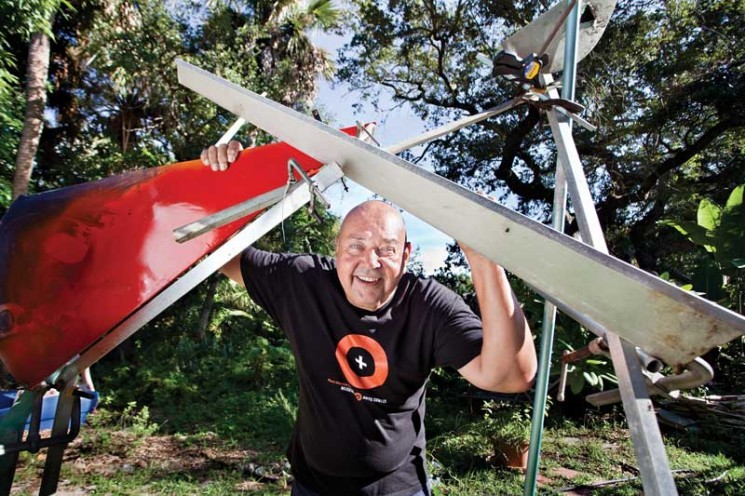
INDIAN RIVER COUNTY — Witnessing the pieces on Bob Coon’s north island front lawn, it’s hard to imagine he would consider his art portable. But trailering the towering sculptures across the country has become a fact of life for him.
One purple aluminum piece is still on the trailer, disassembled from its most recent temporary home near Boynton Beach’s city hall.
“I took one down and replaced it with another,” he said of the ebb and flow of exhibition his works enjoy.
Coon just returned from Raleigh, N.C., where an 18-foot-tall sculpture called “My Big Red” was unveiled last month along with two other pieces as part of a downtown arts festival. It will remain on display for a year.
In December, Coon’s works will be shown closer to home in an exhibit in McKee Botanical Garden.
Coon is a former artist-in-residence at the Vero Beach Museum of Art, named along with the late Haydn Davies, a Canadian sculptor, when the museum first opened in 1986.
As such, his large-scale pieces were often built at the museum, as guests wandered in and out of the sculpture studio while he worked.
They asked questions, he stopped to answer, and that back-and-forth felt meaningful to him.
“I was frankly amazed – I talked to people constantly,” he said of the paid appointment, funded by a museum donor. “I was making the sculptures there and anybody and his or her brother or sister could walk out and say, ‘What’s that guy doing? Let’s go ask him.'”
That piqued curiosity drew them back to the museum, he said.
“There were people who came back regularly to see the progress I was making. They would see not only art hanging on the wall but art happening right before their eyes.”
When after several years, funding expired for the artist-in-residency program, he began to offer classes there both in metal fabrication and lost-wax casting. He also ran the museum’s foundry.
There, outfitted head-to-toe in protective gear, he would oversee the process whereby bronze is heated to a white-hot 2,000 degrees, poured into highly heat-resistant molds – made of the same material as the space shuttle exterior tiles.
Those molds were formed around the student’s original wax sculptures and placed in a 1,000-degree kiln where the wax would have furiously melted away.
When the molten bronze poured into the mold cooled, and the mold was removed, students could take home their sculptures.
For Coon, who turns 70 later this month, the physical endurance required for casting was beginning to elude him.
“It’s so hot, when you’re covered with the leather apron, the mask and the heavy gloves.”
So after nearly 50 years of bronze work, he has switched to metal fabrication. Rather than work in the museum’s studio, he now works at home, in his garage or his back yard. The manual labor is still intense – sanding, grinding, painting, welding.
“I’m not one of these guys who hires a couple of guys to do the grinding and welding, or takes something down to Suncoast Paint and Body to get painted.”
As a result, he may spend a year on a particular work.
In a way, metal work is in his roots. He was born in tiny Bessamer City near Charlotte, N.C., a town named for an iron smelting technique used there in the 1800s.
An only child, he is the son of a carpenter – and that clicked with him.
“I remember sitting in his lap and him drawing for me when I was very small.”
His mother taught math, something Coon never grasped particularly well.
But she understood the need for instruction.
“In our school system, there was no art program. There was a lady in town that had a little studio and she offered classes. My mother decided I needed to go.”
Coon continued training with her well into high school.
“I can remember sitting there one Saturday morning, thinking about what college I wanted to go to, and thinking, ‘This is what I want to do.'”
He enrolled at the University of Georgia, and earned a bachelor of fine arts degree in painting and drawing, then followed a favorite professor north and earned a master’s in sculpture and printmaking at the University of Massachusetts.
Meanwhile, he had met and married his wife, Judy, a librarian.
The couple found work at various colleges and universities – she in the libraries, and Coon teaching sculpture and painting.
Eventually in the mid-1980s, Judy Coon landed a job setting up the new library for Sebastian Elementary.
When Sebastian River High School was built, she took on the task of setting up its library, and continued to work there until retirement in 2006.
Coon had no idea the museum existed when he relocated here, as he puts it in his North Carolinian colloquialism, “If I’d run into a wall and the museum was behind it, I wouldn’t have known it was there.”
Today, although he is not teaching a class there this semester, he has a loyal following of students who have cast bronze sculptures with him every year for 20 years, he said.
Teaching and serving as foundry master is no longer “my cup of tea,” he said. “But I don’t want to stop making sculpture.”



